Casablanca
On the first stage of my Moroccan tour and a three hour drive is planned for today. With seven other travellers ranging in age from forties to eighties, I am being driven in a smart mini bus by the driver, Mohammed, with the guide, who introduces himself as Jesus, though uses his Berber name. Both are Berber or ‘Amazigh’, and Muslim. Berbers were the original inhabitants of Morocco and other parts of north Africa long before the Arabs arrived. The Greeks it was, who were responsible for giving them the name ‘Barbaros’, i.e. ‘Berber’, which referred to anyone who did not speak Greek.
“Yallah yallah!”exclaims our guide. Let’s go! The peachy red buildings and palm trees of Marrakech are soon replaced by plains of brownish stony soil. The odd flock of sheep passes by; wild dogs, a few cattle and camels sharing space, donkeys and carts, men attending the fields, and distant hills. “The economy here is based mainly on agriculture”. “Tomatoes”. “You have Moroccan tomatoes in UK,” looking in my direction. Indeed. “And peaches, apricots, vines and avocado”. “The second most important industry is tourism”. Perhaps, I reflect, they need to get their entry process a touch more streamlined. “The third is phosphates.” Oh. This is used for fertiliser and exported to the EU and African nations. “We have very good trade with the EU,” we are informed. “We also have gold and silver mines. But no petrol. So we need to increase renewables”. Oh yes. And I begin to notice many solar panels in the surrounding fields.
We are now approaching Casablanca, “the main economic city in Morocco, where the top international businesses are based”. Looks like many other big cities with its tall white office blocks. It seems that different cities in Morocco choose different colours for their buildings. Here the colour of choice is white, though the city taxis are red, while in Marrakech are those peachy red buildings and sandy yellow taxis.
We are dropped off on the esplanade where a poster of Humphrey Bogart and Ingrid Bergman greets us. The city still reaps rewards from the famous film, ‘Casablanca,’ even though it was filmed in 1942 in the USA, none of it in Morocco. Shows some prescience. Rick’s café is a re-creation of the famous bar with a piano playing jazz hits of the era. We were to pass by in the bus later to view it from the outside. Fully booked for this evening.
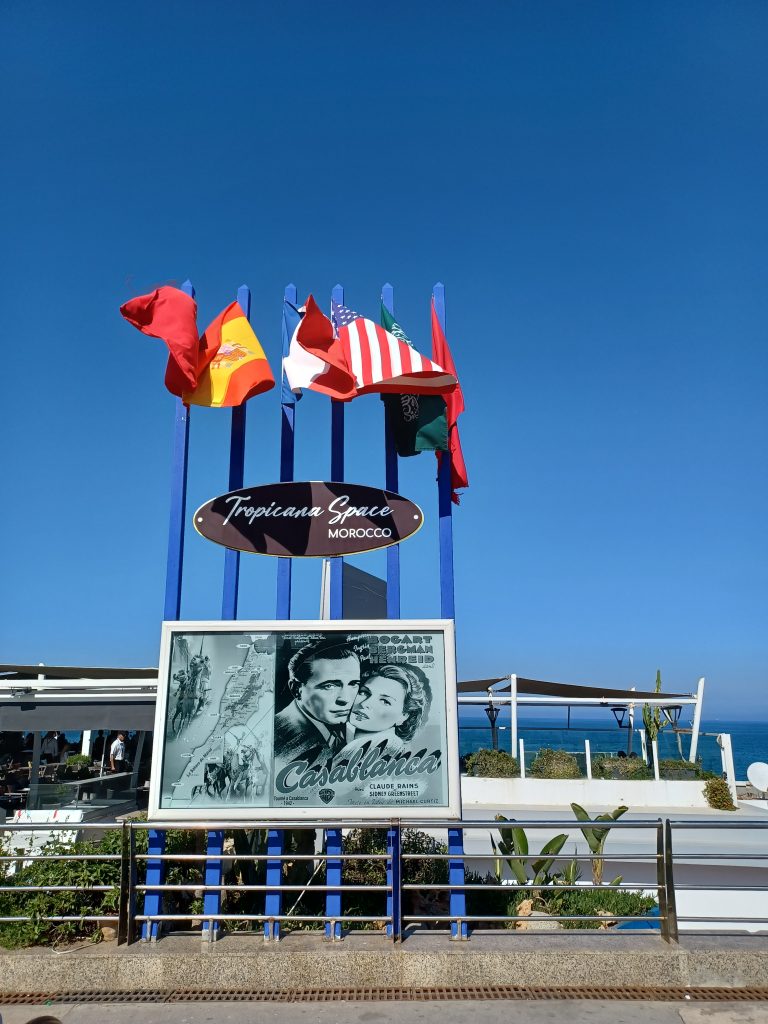
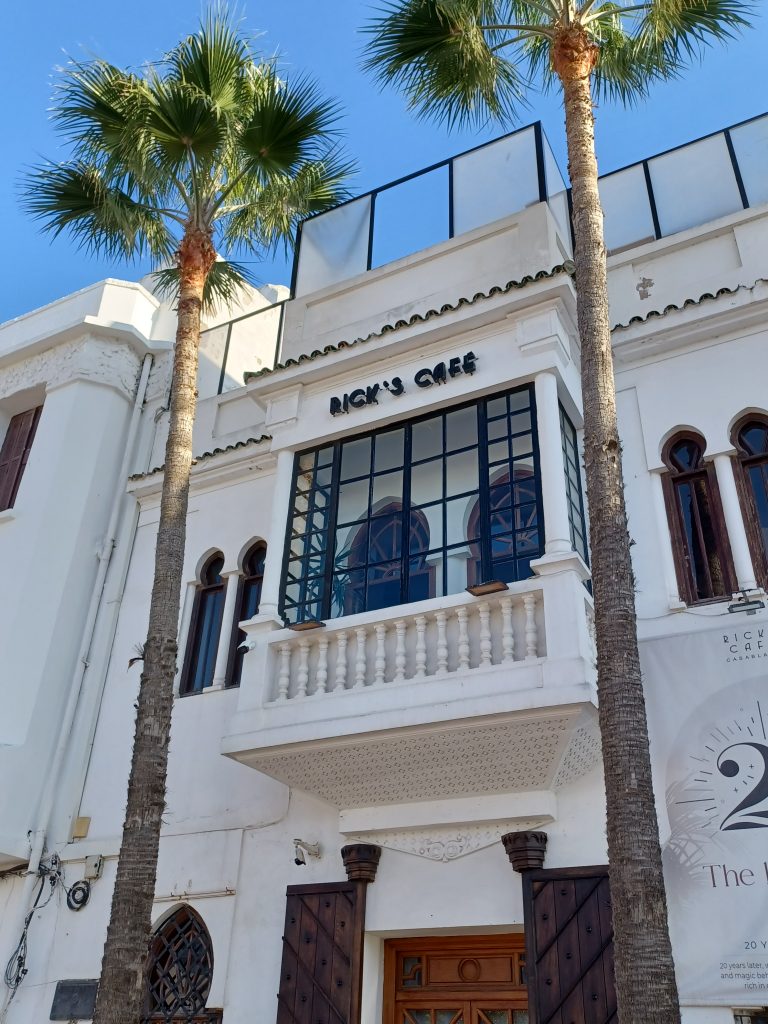
Anyway, I leave the poster and wander off down the esplanade. A musician is playing his guitar and singing ‘Knocking on Heaven’s Door’ as I pass, surf runs up the beach and flags fly. Find an outdoor eatery and watch the waves pound the beach and a few birds circling. All rather good.
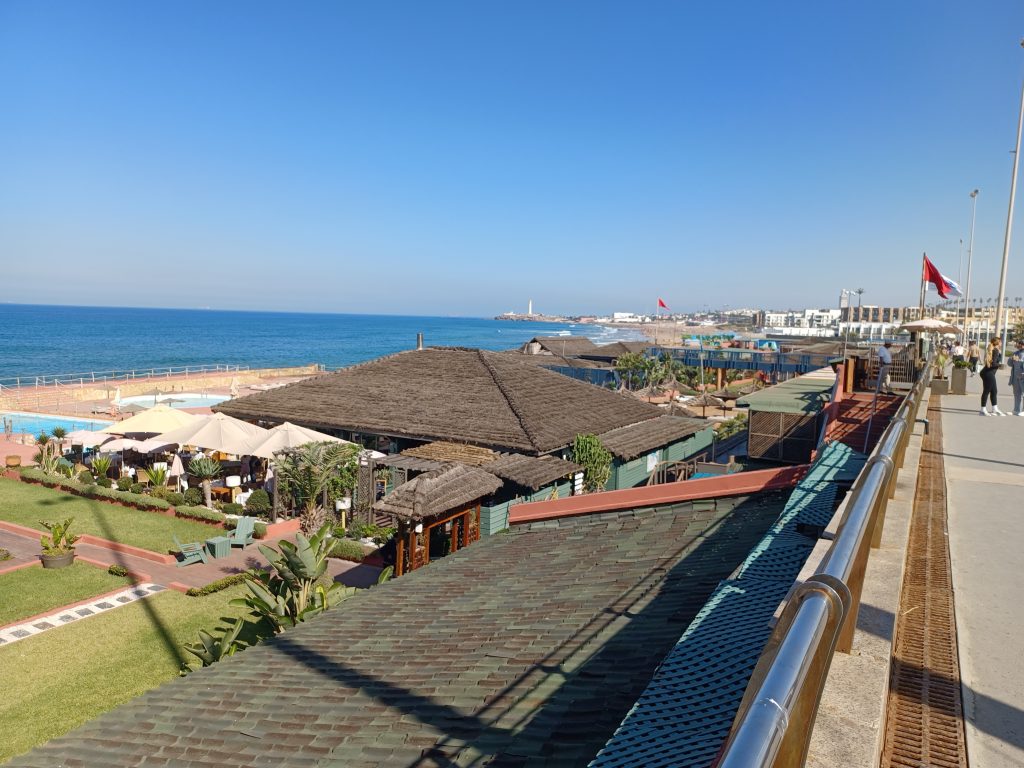
King Hassan II Mosque
An optional excursion this afternoon is to the King Hassan II Mosque. This mosque is the third largest in the world after those in Mecca and Medina, so we are told. It is certainly the largest in Africa. Huge and splendid building with a minaret over 200 metres tall, designed by a Frenchman and completed in 1993. Muslims all over Morocco contributed towards its construction, which cost several hundred million dollars, I gather. The mosque is sited on a promontory sticking out into the Atlantic. There is a verse in the Koran, which says that God’s throne is on the water. Ergo, King Hassan wanted the mosque to be built over water. Could be issues if sea levels rise, although breakwaters were built to protect it.
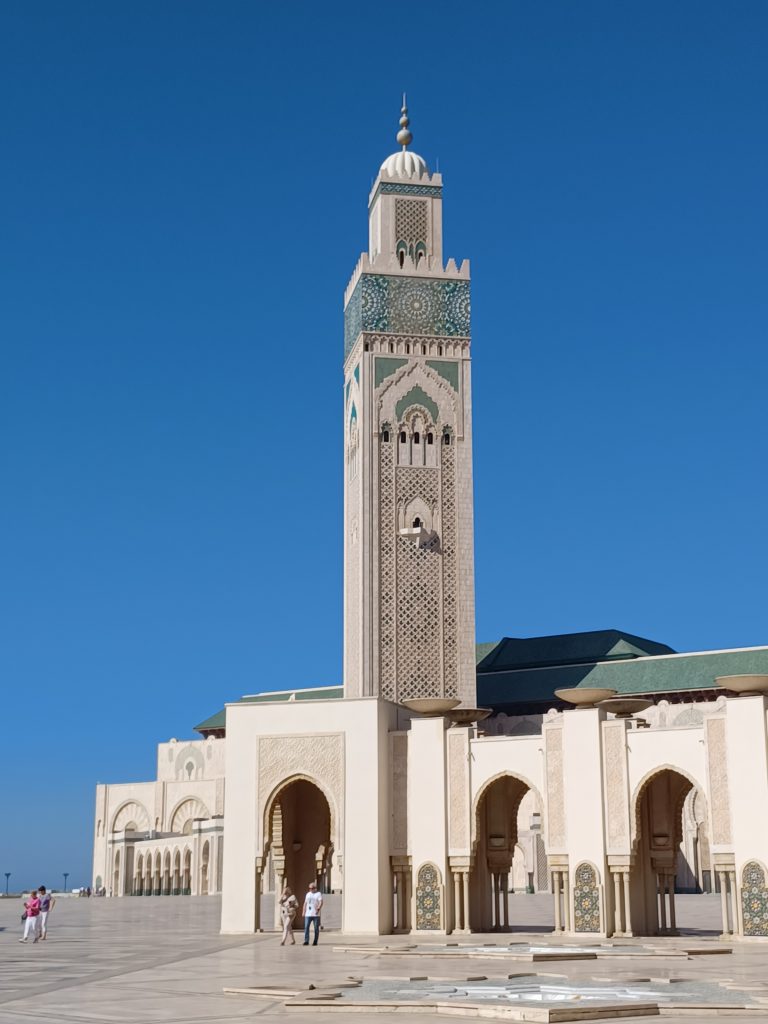
Inside it is all shiny floors and red carpets, intricate carved decorations and Arabic calligraphy. A rather gruff guide takes our English speaking group around at the same time as myriad other guides with myriad other tour groups speaking different languages. Plenty of space for us all. We are told that the mosque can accommodate 5,000 women and 20,000 men inside, and 80,000 worshippers outside. “All the materials used to build the mosque were from Morocco.” “Just some of the granite for the interior columns” and he waves in a random direction, “some marble from Carrara, and chandeliers made of Murano glass came from outside”.

“The women pray upstairs” and he points to the lattices made of cedarwood “from the Atlas mountains”, while the men pray downstairs. “The roof is retractable”. We all gaze upwards. Impressive. This is so that worshippers can worship under the sky.
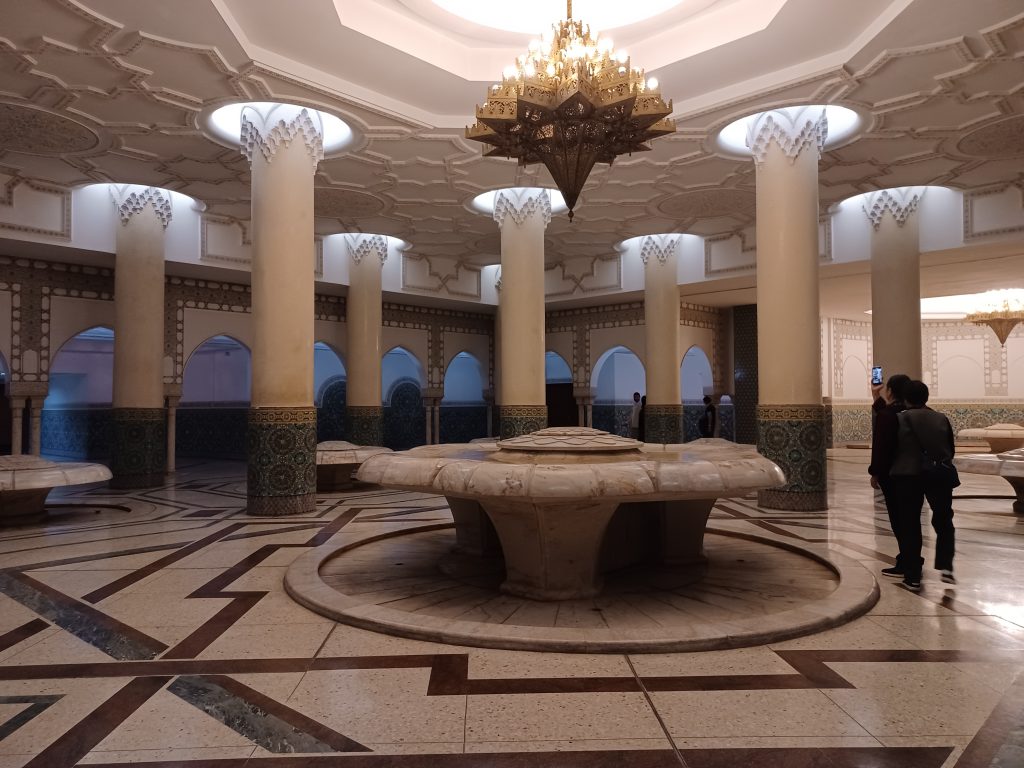
The ablutions area is almost as huge as the areas of worship and we venture down some steps below ground level to view these ‘ablution halls.’ Pristine and shining, they contain 45 fountains which represent lotus flowers.
As before mentioned (see Morocco, Part 1: Marrakech), this is the only mosque in Morocco in which non-Muslims are allowed. King Hassan II made the decision that it should be open to tourists. The French it was though, who originally decreed that non-Muslims should not enter mosques in Morocco. Anyway, the guide tells us it is not very busy except over Ramadan. Expensive to maintain such a grandiose structure so little used, I feel. The tourists no doubt, help keep it in funds.
Rabat
Further along the coast is Rabat, capital of Morocco. Our next stop. Wide boulevards lined with fig trees greet us here. It is very clean and ordered. Pick up a local guide to view the highlights, first of which is King Hassan II Palace, where the late King used to live, though his son, the present King Mohammed VI, chooses not to. Brief look at the outside of the handsome looking palace with large fountain in front.
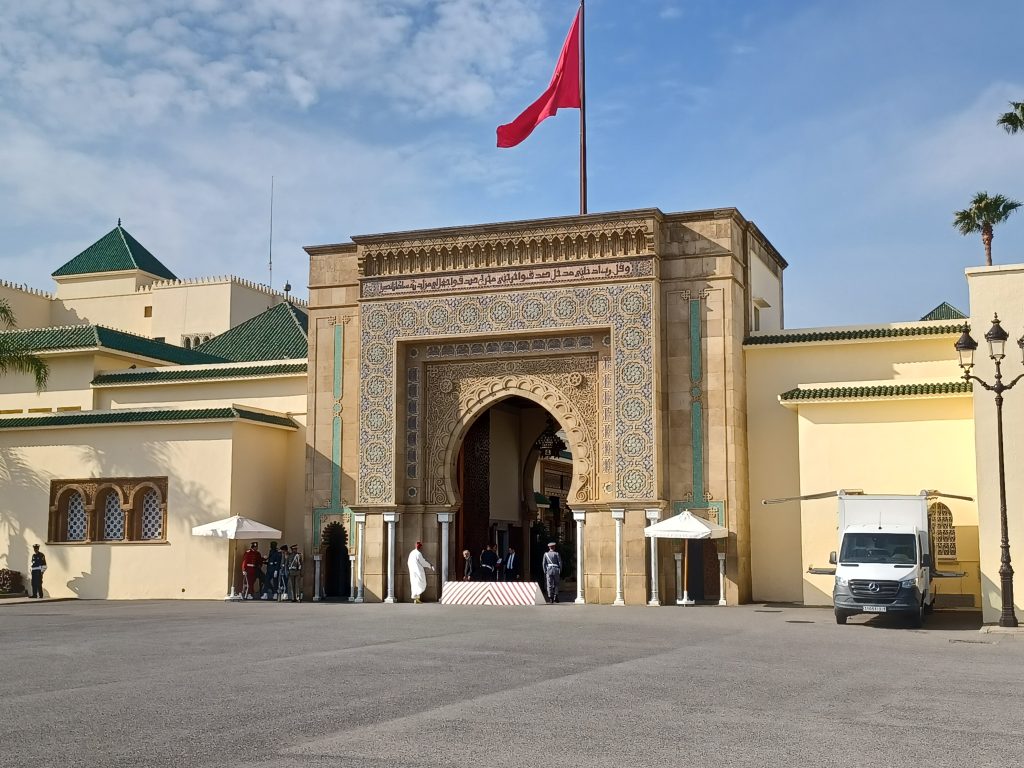
It was used to welcome President Macron of France recently, we are told. France is an important ally.
Hassan Tower and the Mohammed V Mausoleum
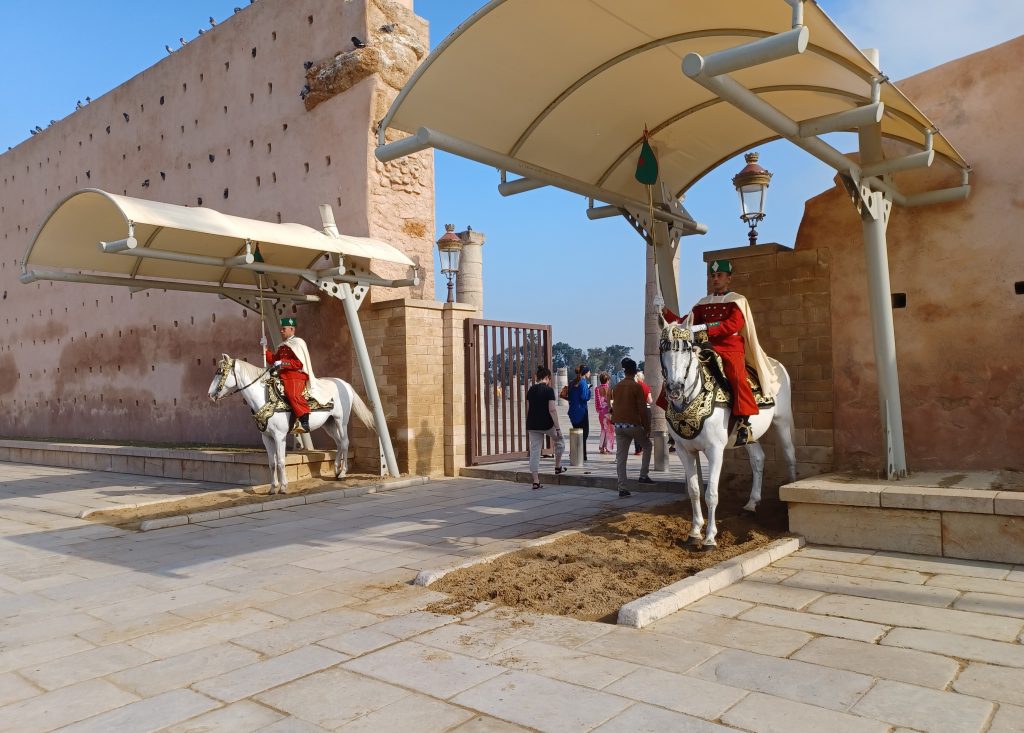
From there to the Hassan tower and the Mohammed V mausoleum. We approach the entrance to the complex, which is guarded by two Royal Moroccan Guards in red uniforms and white capes atop white horses. Pass through the gates.
The Hassan tower was built in 1195 by the Almohad dynasty and was modelled on the Giralda and Koutoubia mosques. It is half the height it was supposed to be, 44 metres, as the Caliph, Yaqoub el-Mansour, who had wanted to build the world’s largest mosque, died in 1199 during its construction.
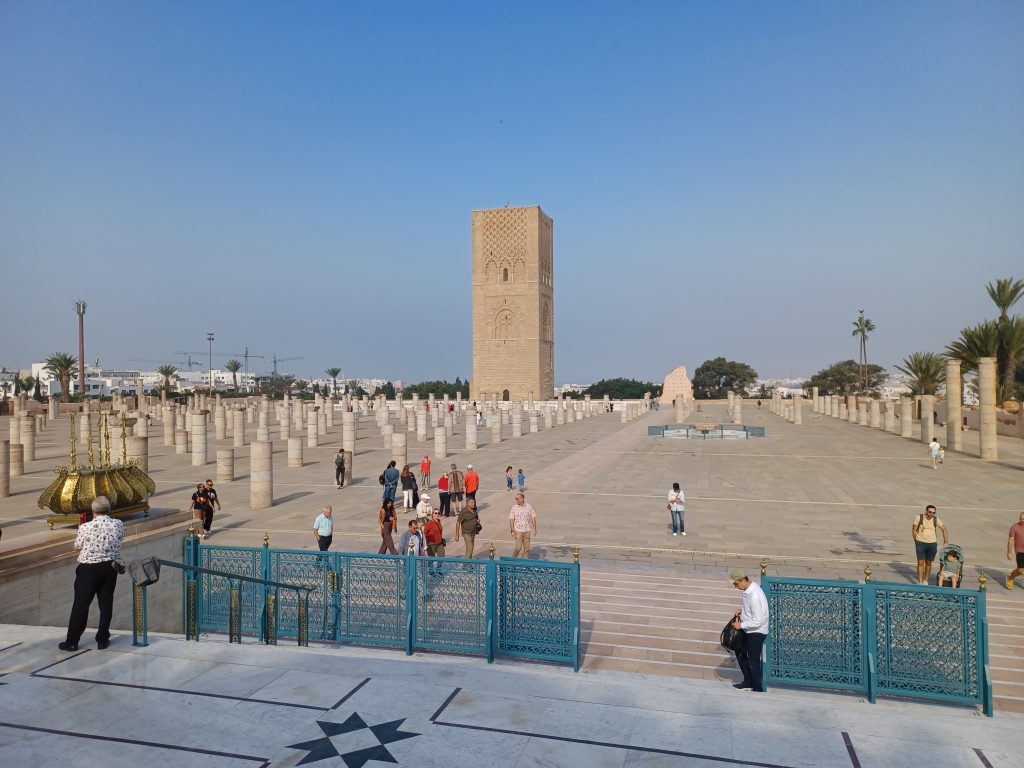
The minaret, the Hassan tower, was the only part remaining after the devastating 7.7+ magnitude Lisbon earthquake of 1755 destroyed everything else. Stumps of the original Roman columns brought from Volubilis (see below),which held up the roof of the mosque, are arrayed in neat lines about the complex showing how vast it would have been. The site was left for centuries until Mohammed VI built another mosque on the site and decided to use the Hassan tower as its minaret.
The mausoleum with its green tiled roof (the green colour represents Islam), a short distance from the Hassan tower across the Yaqoub el-Mansour Square, was commissioned by King Hassan II for his father, Mohammed V. Greatly revered, Mohammed V it was who led Morocco to independence. “It took ten years to build the mausoleum”, we are told, due to its incredibly intricate and beautiful decor. Cedarwood, zellij tiles, calligraphy, Carrara marble, gold leaf, stained glass, this magnificent mausoleum has it all. Moroccans certainly honour their late monarchs. We spend time admiring the interior, while guards stand on each corner of the gallery keeping a critical eye on selfie snapping tourists, and gaze down upon the dazzling white onyx sarcophagus below. Mohammed V’s two sons, King Hassan II and Prince Moulay Abdallah, were buried here after their deaths. Rather smaller sarcophagi.
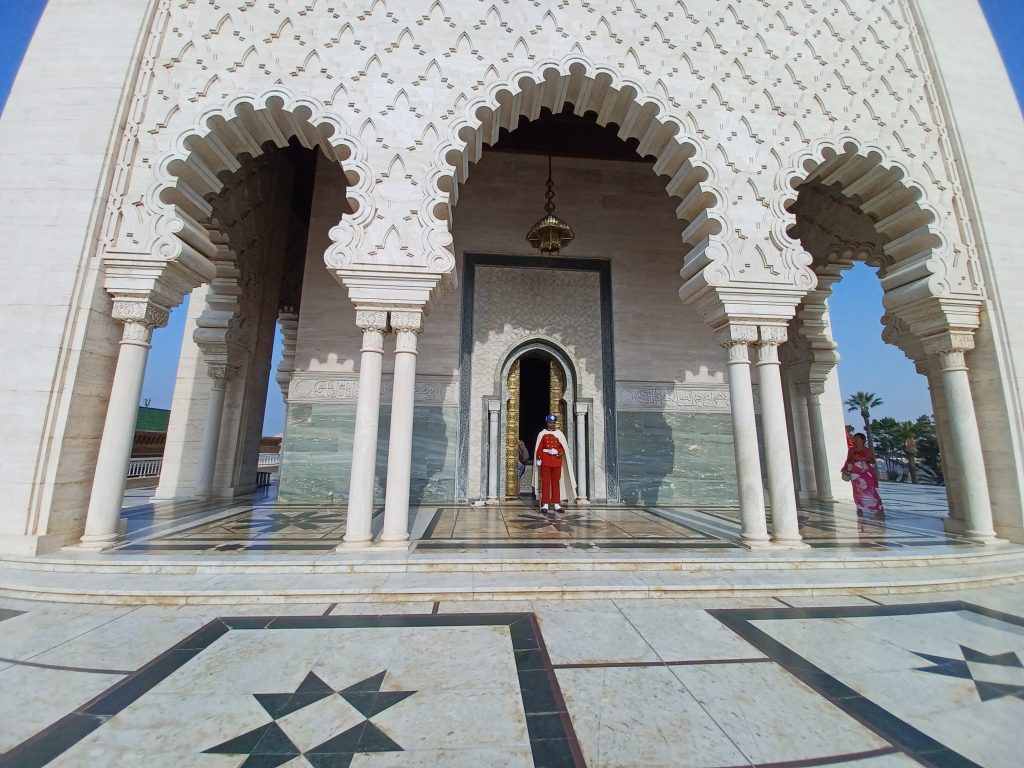
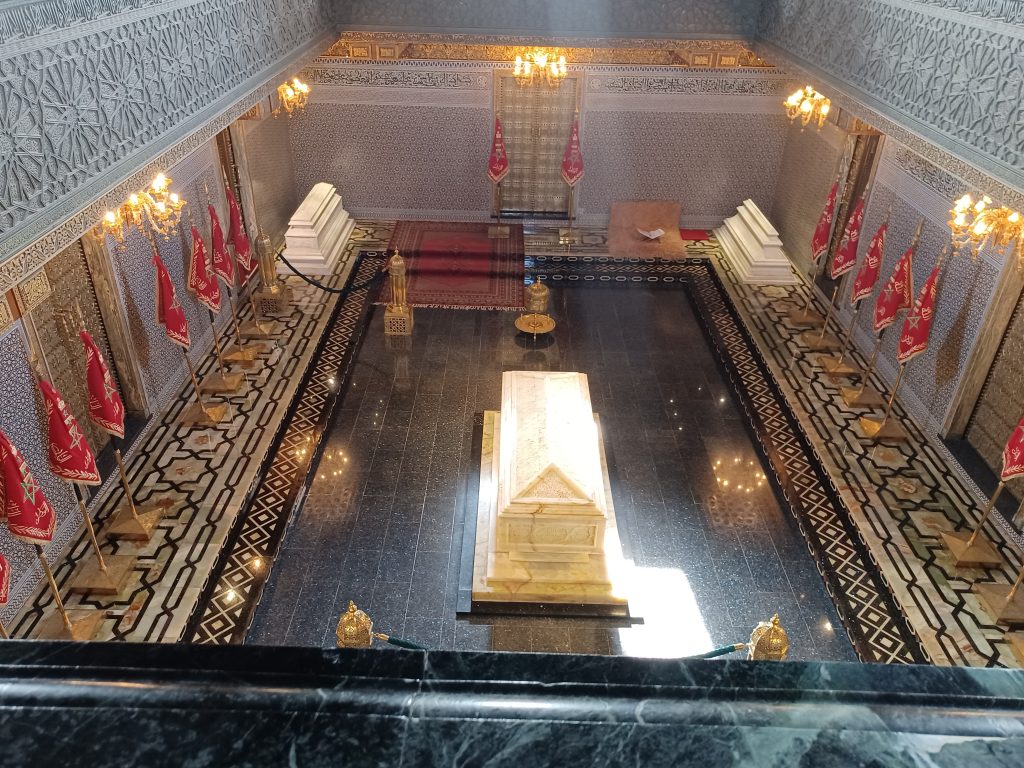
There is a fine view of the city from the other side of Yaqoub el-Mansour Square and the mausoleum. Two of the Royal Guards on horseback are patrolling the road. Maybe the changing of the guard has just taken place in front of the gates.
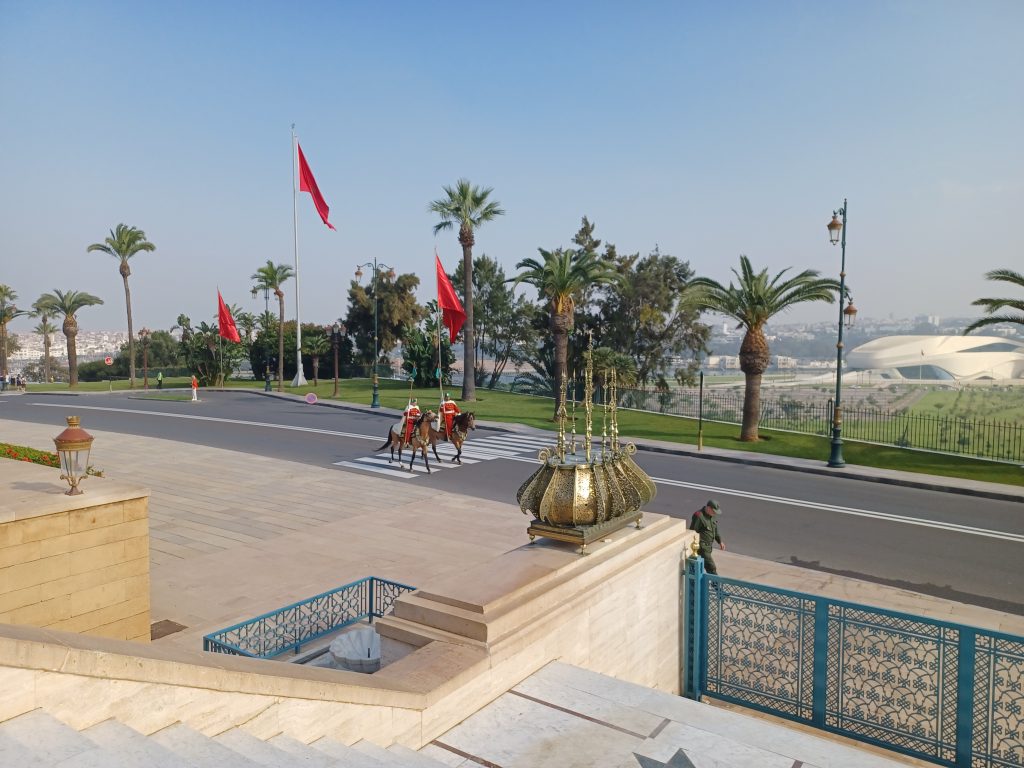
Kasbah of the Udayas
A short drive ensues to the Kasbah of the Udayas, built by the Almohads in the twelfth century. “Yallah yallah” intones our guide. We alight near the entrance to this UNESCO heritage site and view the Bab Udayas, the monumental gate to the Kasbah (fortress), shaped like a horseshoe with elaborate carvings around it. Said gate was added to the Kasbah by the same Yaqoub el-Mansour who built the Hassan tower. This gate was used in the filming of ‘Mission Impossible’ in which Tom Cruise careered down the steps in front of it in a chase scene. A bouncy experience no doubt. Make a mental note to watch the film.
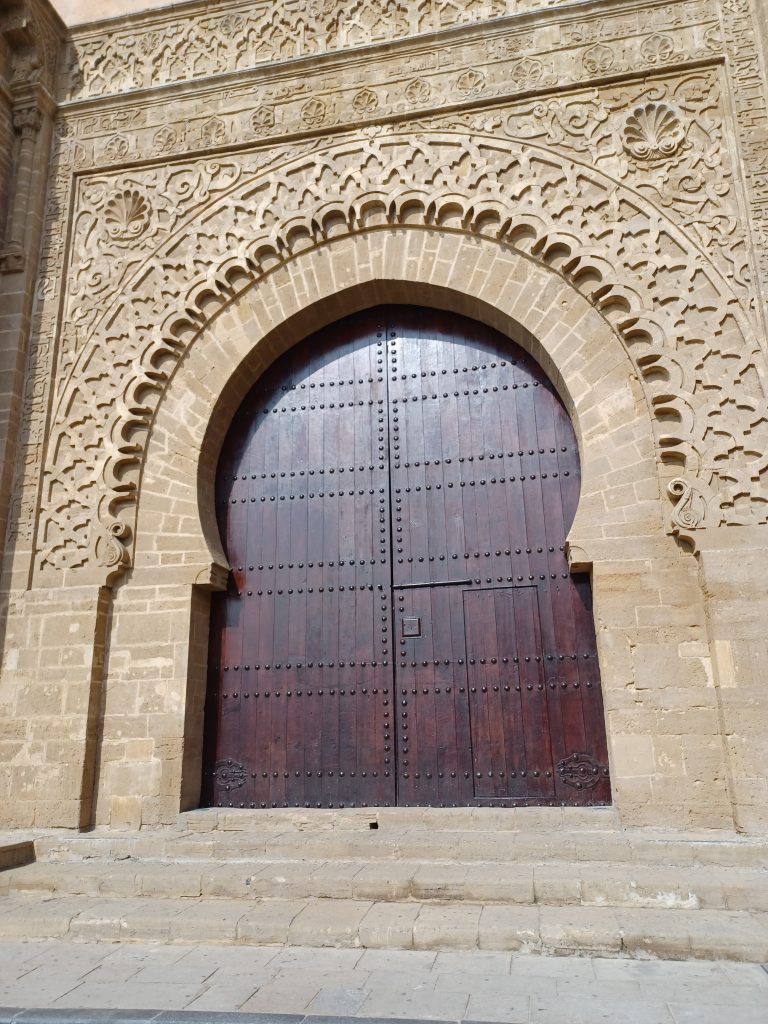
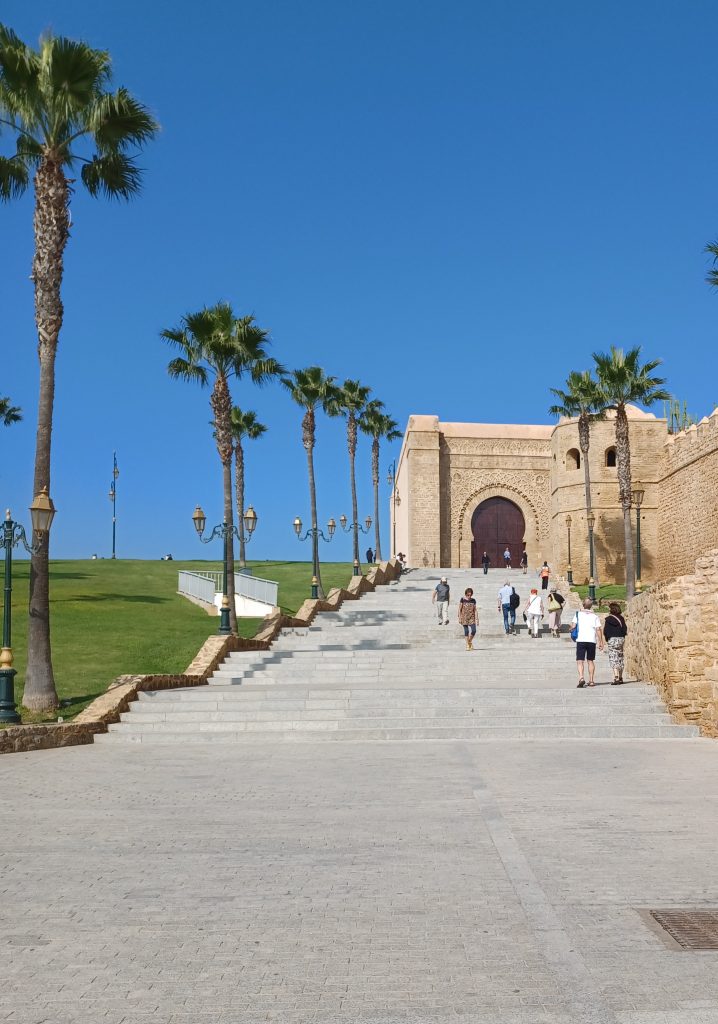
Inside the kasbah we find pretty narrow streets with marble paving and white painted buildings, formerly blue, apparently. Street sellers of painted trays and ubiquitous toy camels and fridge magnets line the lanes. The old stone minaret of the mosque protrudes above the buildings.
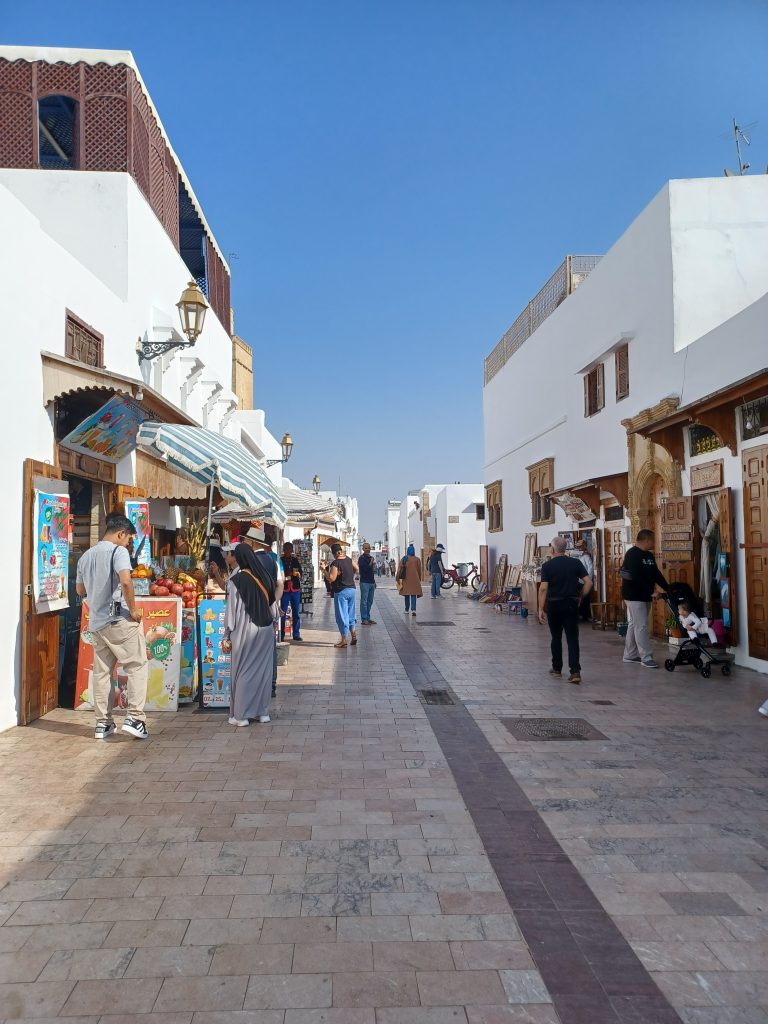
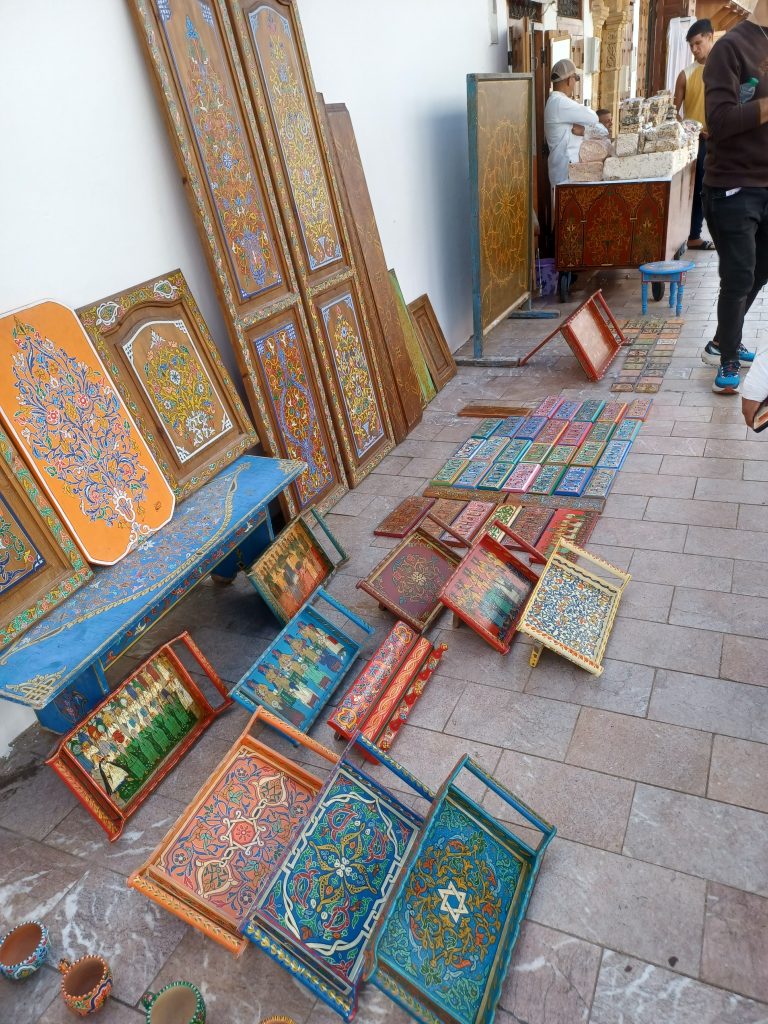
Thence to the lovely Andalusian Gardens within the walls. Inspired by the gardens in Andalusia in Spain and laid out by the French. Much less crowded than the Jardin Secret in Marrakech I have to say. Lush planting including orange trees and bougainvillea. Peaceful and shady retreat.
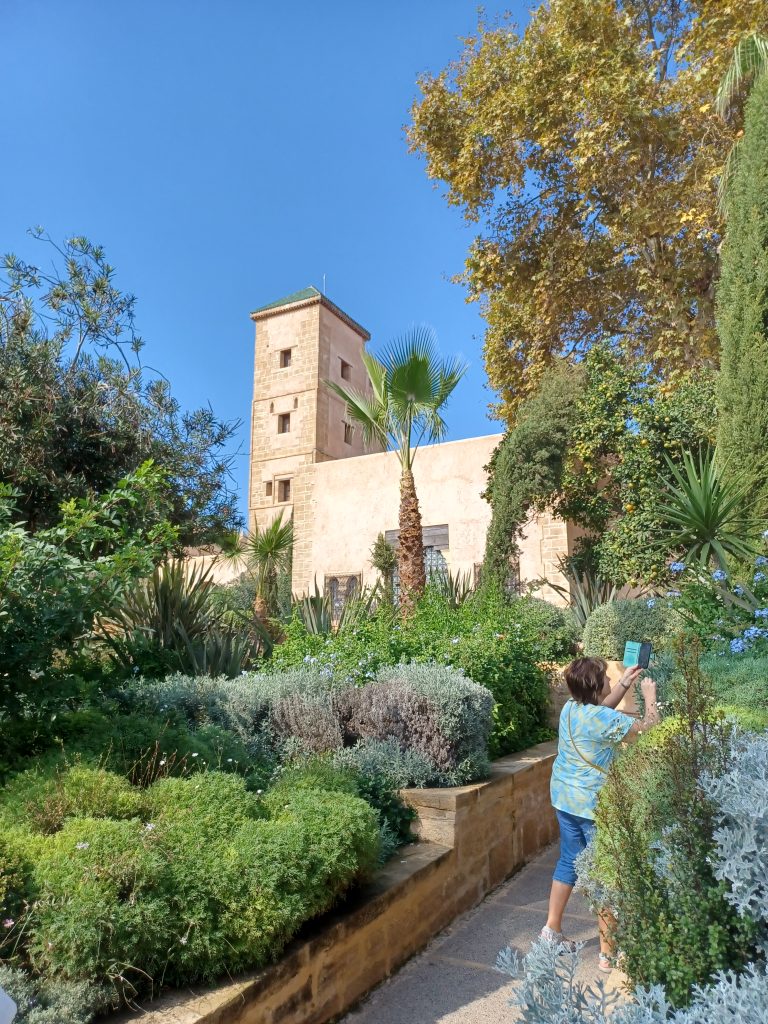
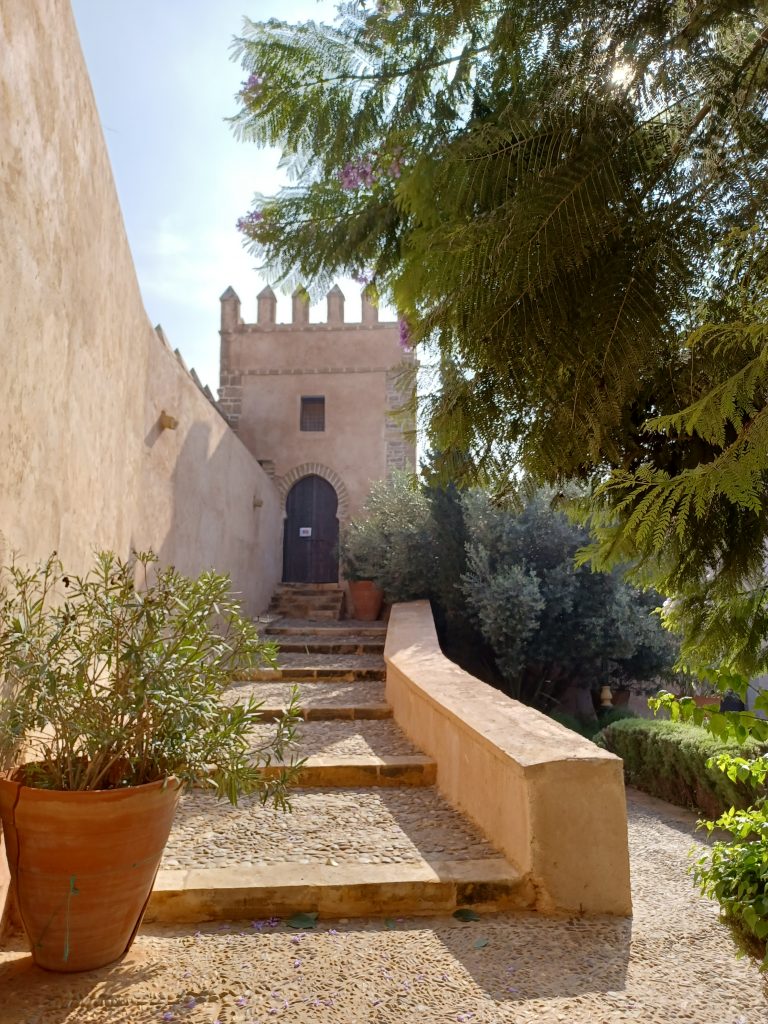
Finish up at the Pirate’s Café, named after the Barbary pirates based here preying on merchant ships in the 17th and 18th centuries. Muslims had been expelled from Spain at that time for refusing to convert to Christianity and some found a refuge in Rabat and turned to piracy – as well as slavery. Fabulous view from the Pirate’s Café overlooking the Bou Regreg, the river running into the Atlantic here between the two cities of Rabat and Salé.
Time for refreshment. We head to the riverside for lunch. Lot of food provided at a long table provided for the group. Seafood on the menu. Glassy river, some fishermen rowing across it between the two cities. Standing up facing forwards. Makes sense. Can see where you are going.
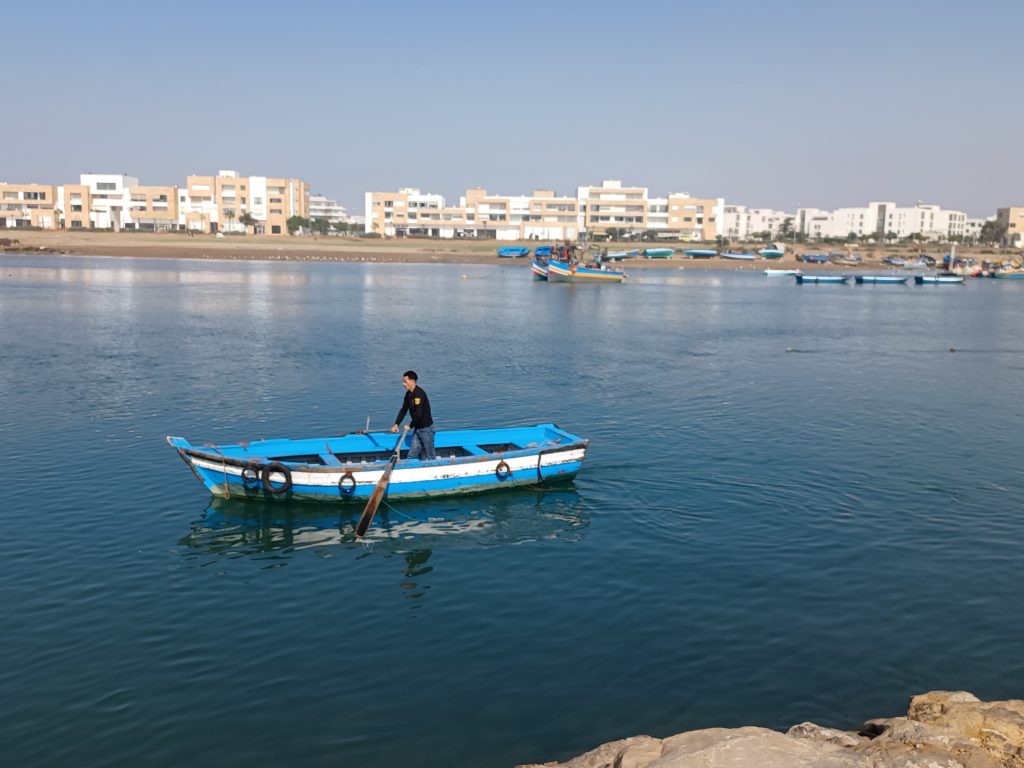
An attractive scene it is with the stripy fishing boats alongside, nets piled on the quay, and the kasbah with the minaret of its mosque in the distance. Could have spent some time wandering about here, and the kasbah too. Rather a gem of a capital city. Yet emptier, quieter and nothing like as frantic as Marrakech. But it is time to hit the road again.
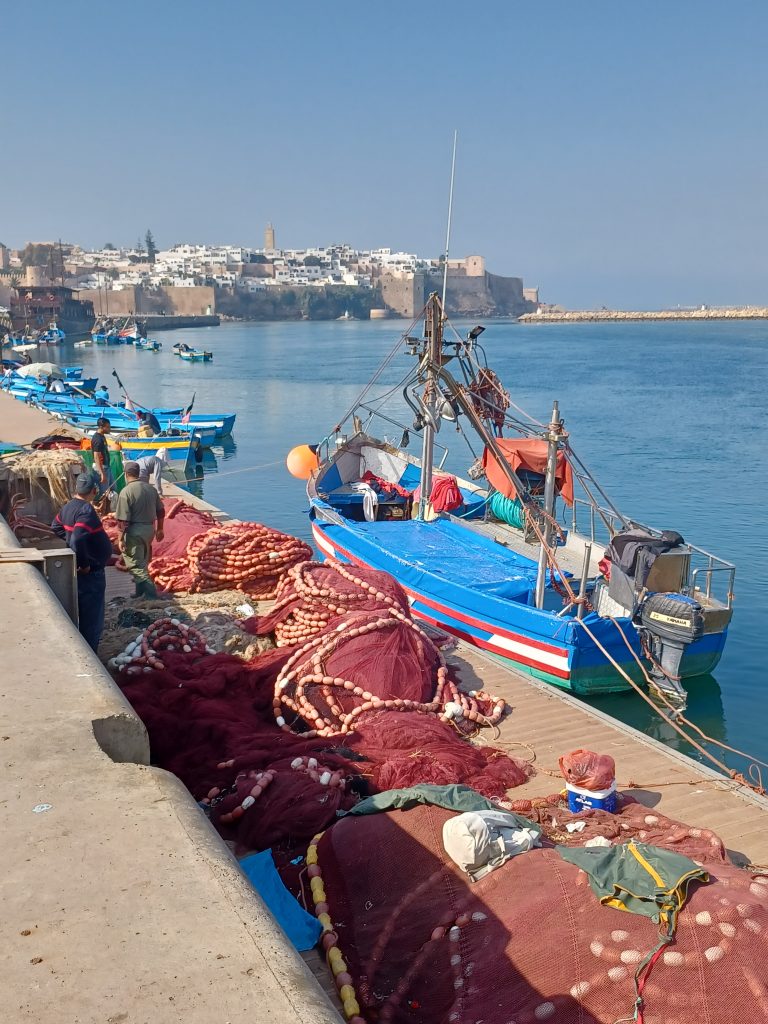
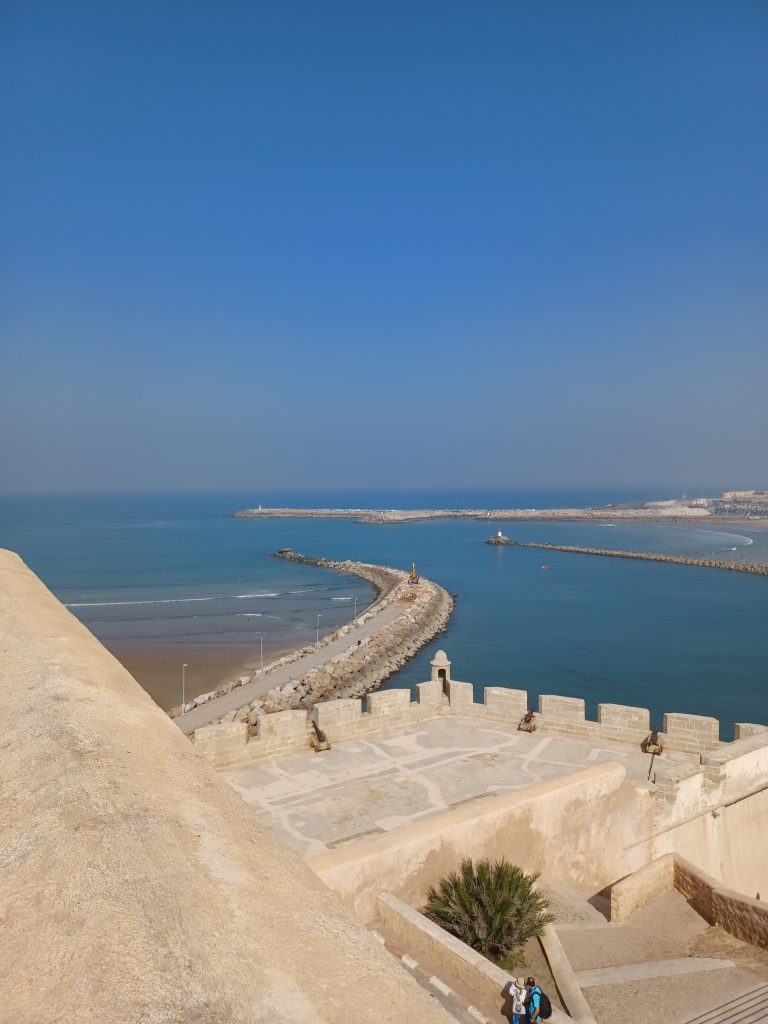
Meknes
Hills become greener, soil blacker and agricultural products apparent as we approach Meknes, Morocco’s fourth Imperial City (along with Marrakech, Fez and Rabat), also the centre of Morocco’s vine cultivation. Meknes was founded by the Almoravids, a Berber dynasty in the 11th century (the same dynasty that built the first Koutoubia Mosque in Marrakech). Drive into the old city through an old medina gate. Have a walk about inside the medina. Plenty of horses and carriages await customers, along with light blue city taxis.
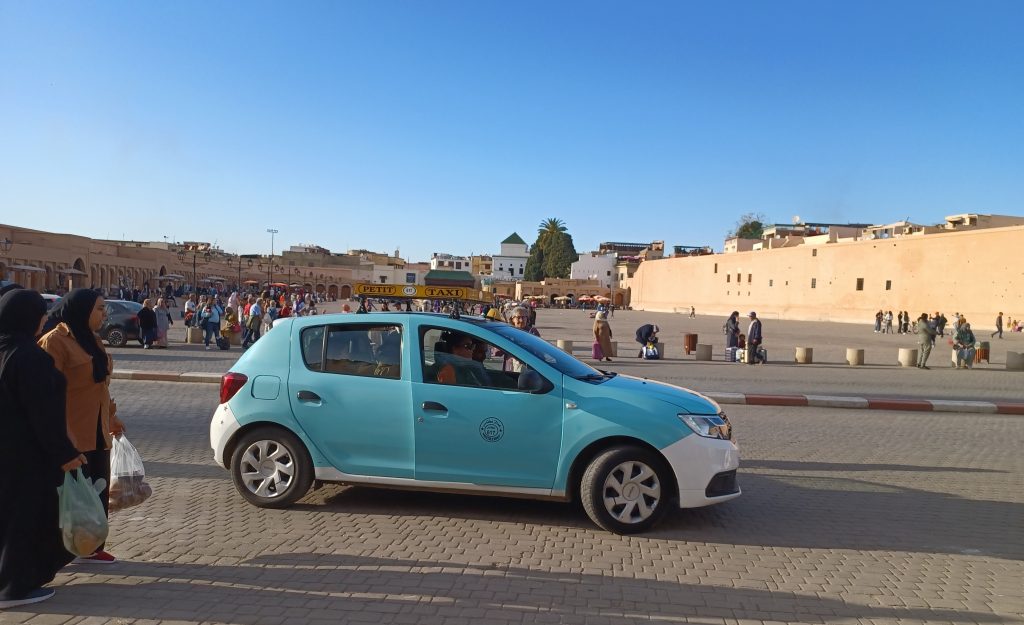
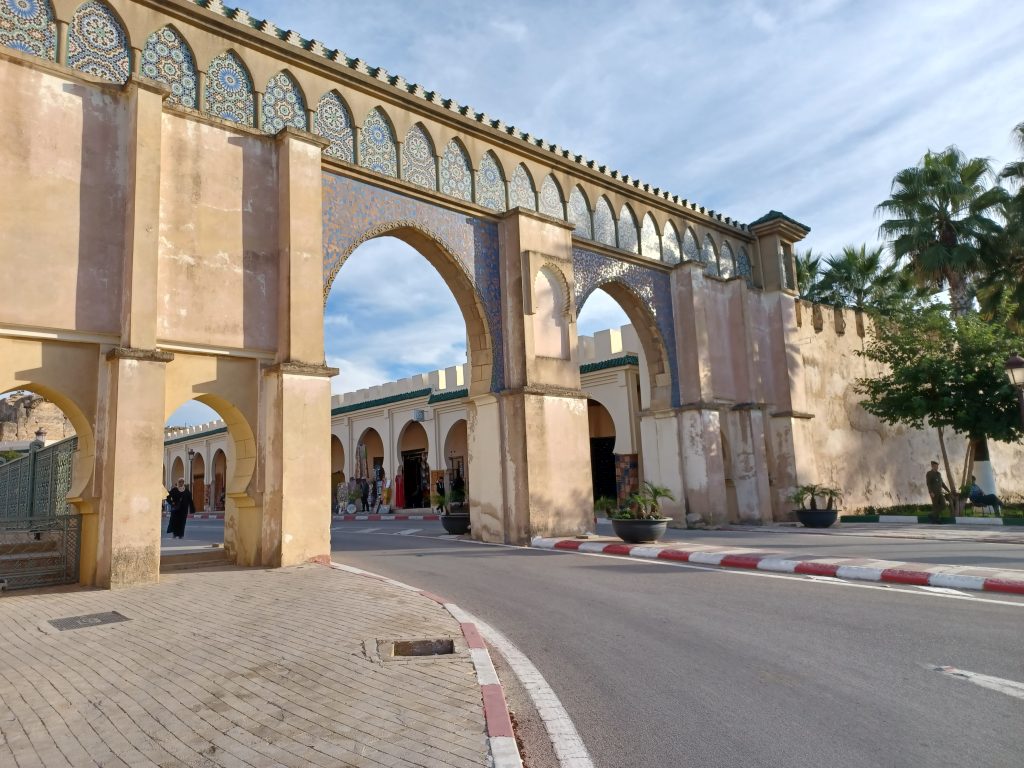
Wander into a huge space, less amorphous than that of Marrakech’s Djemaa El Fna. More snake charmers, monkeys, horses, an ostrich; souvenirs, and a spices and fruit market. As the sun begins to set a flock of storks floats down to roost over the city walls.
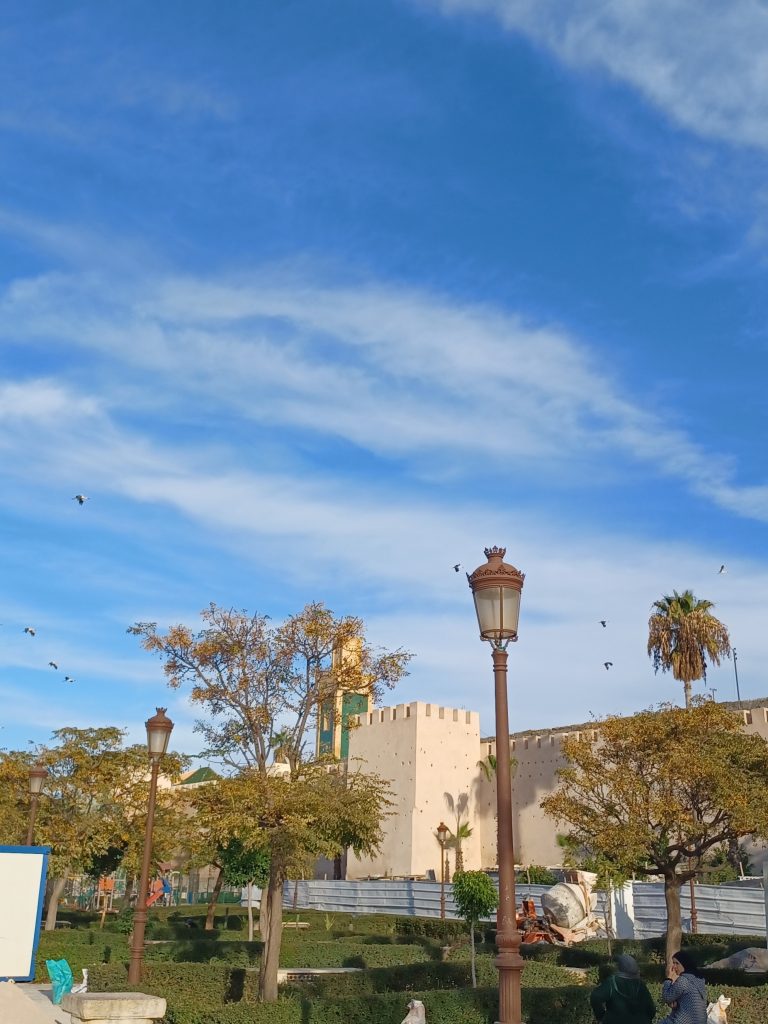
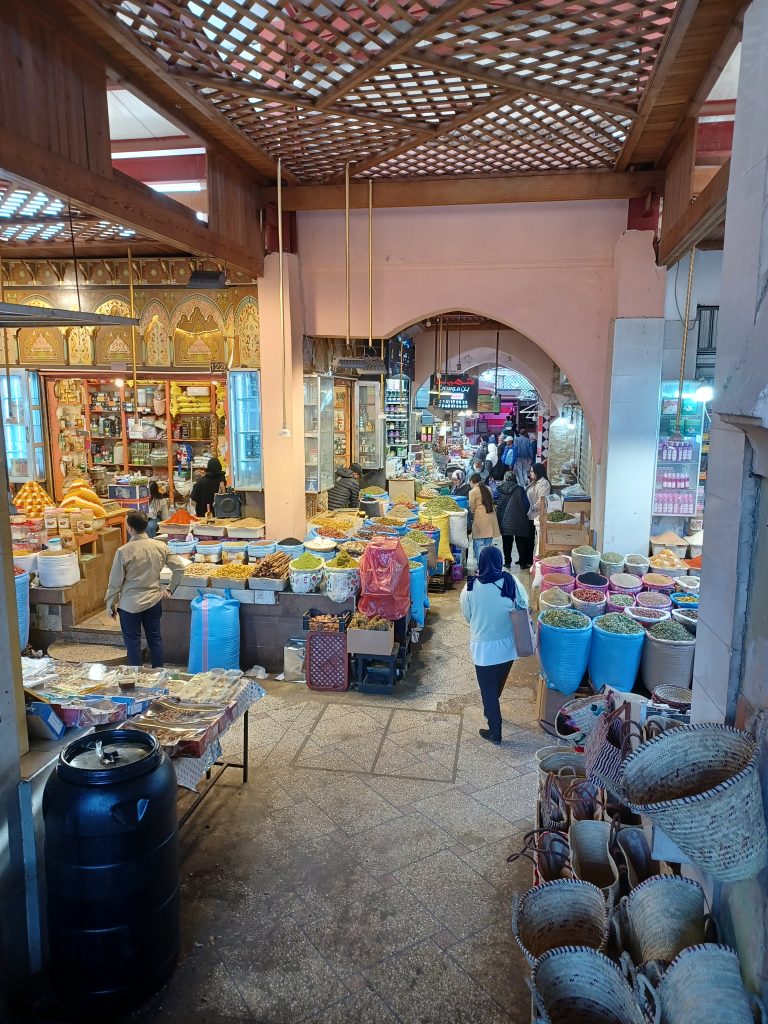
Stay the night in a hotel in Meknes. A bar/disco next door makes a jolly loud nuisance of itself well into the small hours. Results in a few of our number tottering down to breakfast next morning in less than genial mood. I sympathise. I am usually the one suffering from insomnia but last night was oblivious.
Volubilis
Today we drive north from Meknes through black fertile landscapes towards the Roman city of Volubilis. This should be interesting. The city thrived for 400 years or so between about 100 BC and 300 AD and the fertility of these black soils was a prime reason the Romans settled here. Perfect for growing vines and cereals such as wheat. Also olive trees, of which there are plenty today, although our guide tells us “the crop is not good this year because of the drought”. It is actually harvest time right now, and we pass some folks catching the fruits on plastic sheets as the olive trees are shaken. “Orange trees, mainly mandarins and clementines, which we export to Europe, are almost ready now”. There are also agave plants here, we are informed. “Fibres of this plant are used to make silk”. Oh. OK.
Our guide had ensured that we all rose 30 minutes earlier than usual so as to be the first tour group in Volubilis, “Inshallah!” (If Allah is willing). We are. The sun casts long shadows as we photograph the columns of the temple dedicated to the trinity of Jupiter, Juno and Minerva. The local guide, obliging sort of chap, takes a picture of the group at the top of the steps of the temple in the early sunlight on everyone’s phones. Stunning setting and terrific view over the whole site of about 40 hectares. It would have held a population of about 20,000 back in the day when Volubilis was the Roman capital of Mauretania (northern part of Morocco and parts of north Africa).
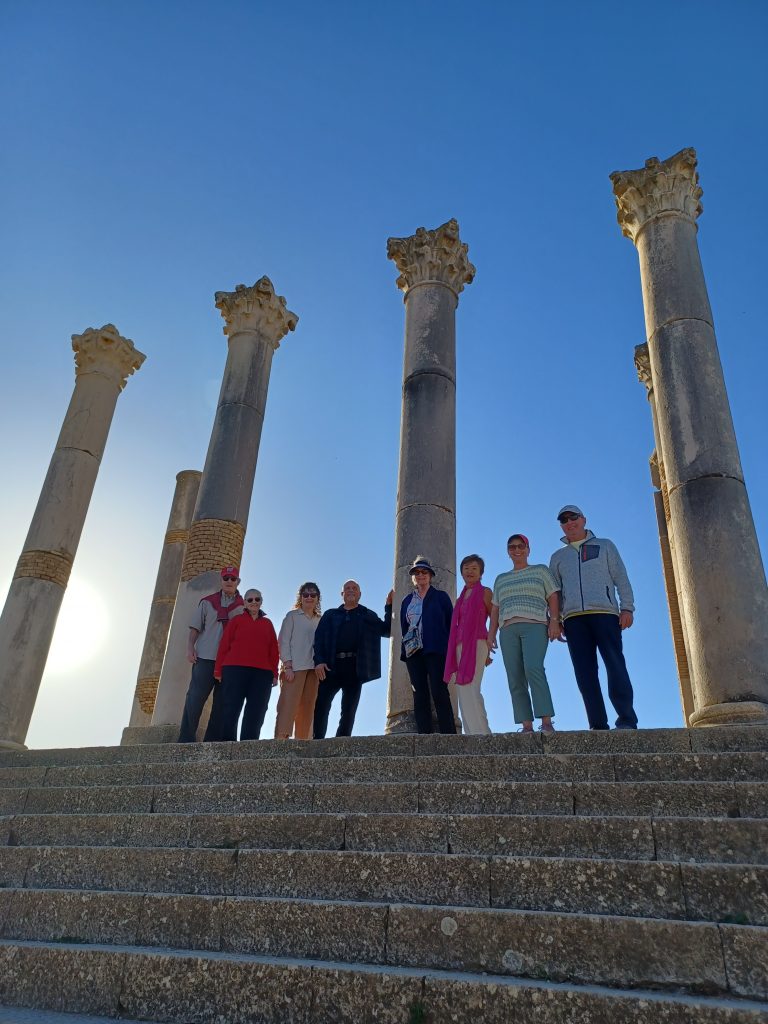
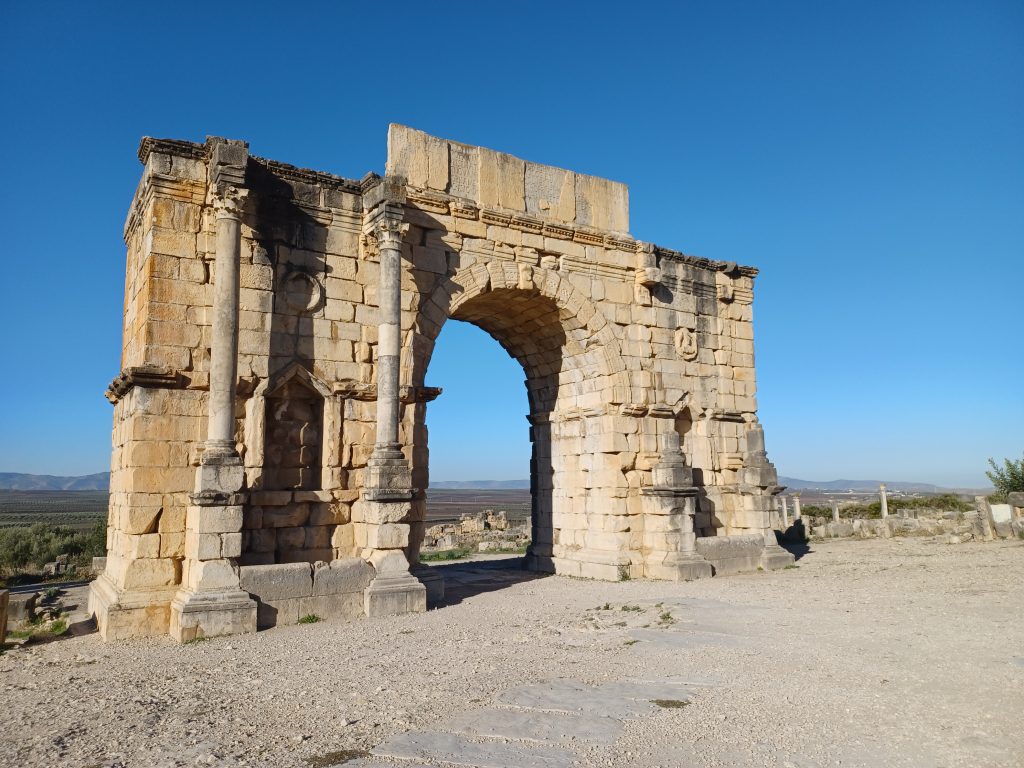
The main and imposing entrance to the city was the Triumphal Arch, built in 217 AD to honour the Roman Emperor Caracalla and his mother, Julia Domna. Once crowned with a bronze chariot and horses apparently. Other monuments include the Basilica, a court area with tall columns and arches.
We pass the remnants of the underground heating system (hypocaust), baths, washing areas and fountains, before wending a well-trodden way on cracked earth pathways in between what were once grand patrician Roman houses. Many of these have mosaic floors still intact in what were their dining rooms or bedrooms. “The dry climate here has preserved the mosaics very well”, says the local guide, looking cool in sombrero shaped straw hat, sunglasses and check shirt. Equally though, he believes, Morocco should do more to preserve its ancient sites. Some of the mosaics have been restored though. One features an athlete riding his donkey backwards, one of the Goddess of hunting, Diana, having a bath, another of Hercules’ labours. Many feature Gordian knots and animals.
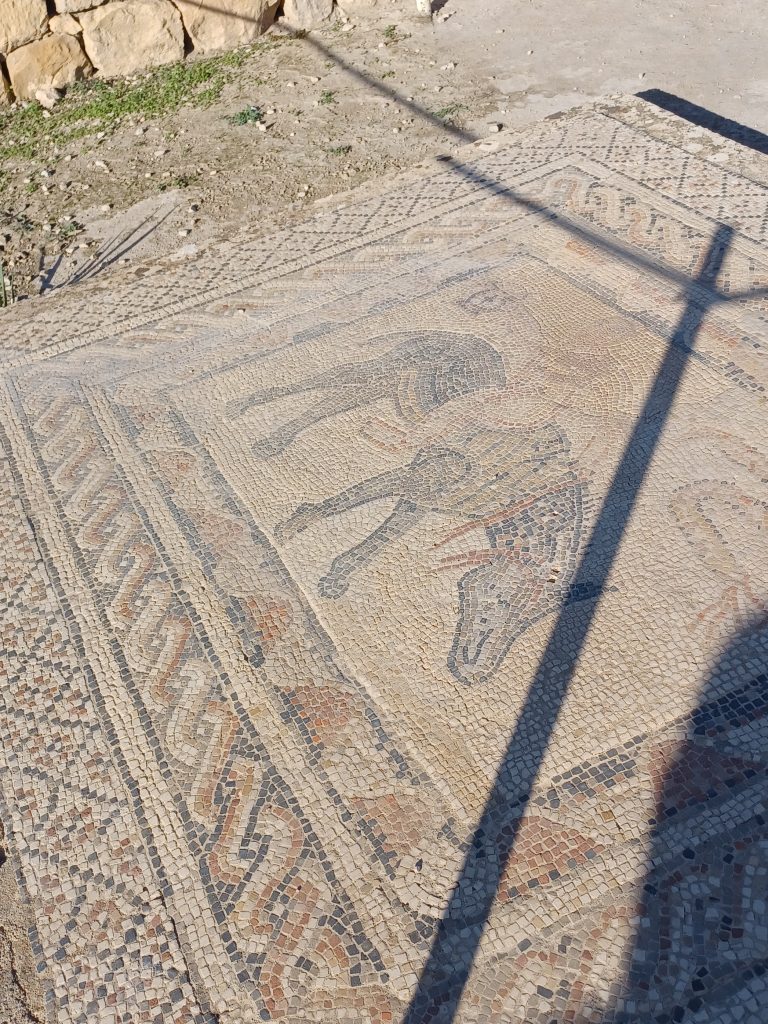
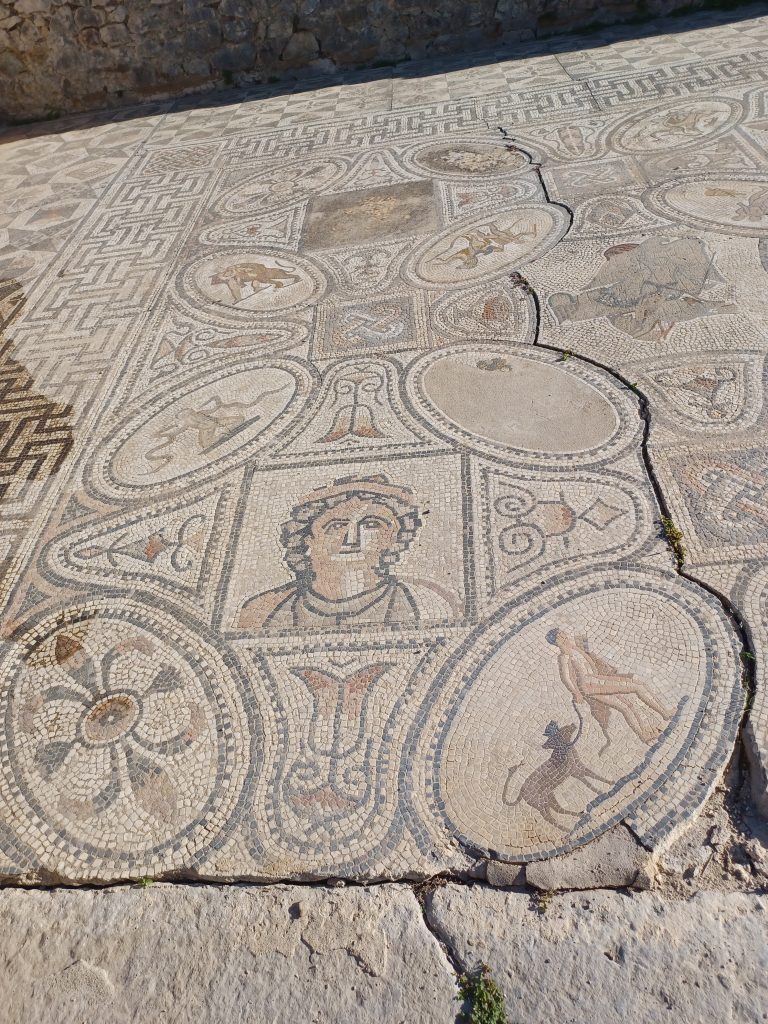
Chariot ruts on the main road, the Cardo Maximus, remind me of Jerash (see Jordan, part 1). There was also an aqueduct here overlooking the lovely hills and fertile plains. Volubilis, as with the Hassan Tower in Rabat, was devastated by the 1755 Lisbon earthquake even though, we are told, the epicentre was 1000 miles away.
Approaching the exit to the site, the local guide points out jojoba bushes and carob trees. “There used to be much prickly pear growing here too”, he says. I tasted some of those reddish fleshy fruits in Marrakech market. “But it was wiped out by cochineal disease”. This beastly insect ravaged the prickly pear crop, which is of high economic value to Morocco and other north African countries where the cactus normally thrives.
We leave Volubilis as other tour groups arrive. Just as the day is getting hotter. Masterful planning. Lunch stop ensues. By a pool. Nice. Moroccan tagines and fruit. Very nice. Resume our drive crossing over the Lukkus river, which was once the border between Spanish and French Morocco and is the third largest river in the country. North of the border, many street names are in Spanish. Longish winding drive over wadis and hills. Wadis are dry, a sign, as we have been told, of the long drought.
Chefchaouen
We disembark for a photo-stop on a hill overlooking the ‘Blue City’ of Chefchaouen. Blue city because most of it is, in fact, blue. Perhaps called ‘Blue’ because blue is the colour associated with Judaism when Jewish people lived here, although there are other reasons postulated, such as that the colour blue repels the dastardly mosquito. OK. ‘Chaouen’ means horns of goat, and refers to the two ‘horns’ of the hills one sees as one enters town from the south. Founded in 1471 a kasbah was built to defend against Portuguese invaders. Moors and Jews, both expelled from Spain, flooded into the city after 1492 (see Spain, part 1).
Chefchaouen is situated in the Rif mountains, home to the cannabis plant, which made Morocco a mecca for the hippies of the 60s. Anyway, the production of hashish, the resin of the female cannabis plant, I understand, is a considerably profitable industry and, as such, forms part of the town’s economy. “Morocco is making the drug legal for medicinal purposes”, we are told, “but we are not allowed to smoke it”. “Legally”. Inevitably, drug traffickers export it to Europe due to the high demand. “The second mainstay of the economy here is tourism”. We will soon find out why. We are given an hour to rest up before walking down to the old city from our hotel and passing through its ancient gate.
I have to say, it is gorgeous inside. A photographer’s paradise. The narrow streets have blue walls and blue steps, which are covered with crafts for sale: bags, rugs, paintings, mugs, chopping boards, traditional clothing – long bright dresses and woollen jackets, brassware, jewellery, fridge magnets. Quite cute, these latter, with little doors in them which can be opened. And pastries.
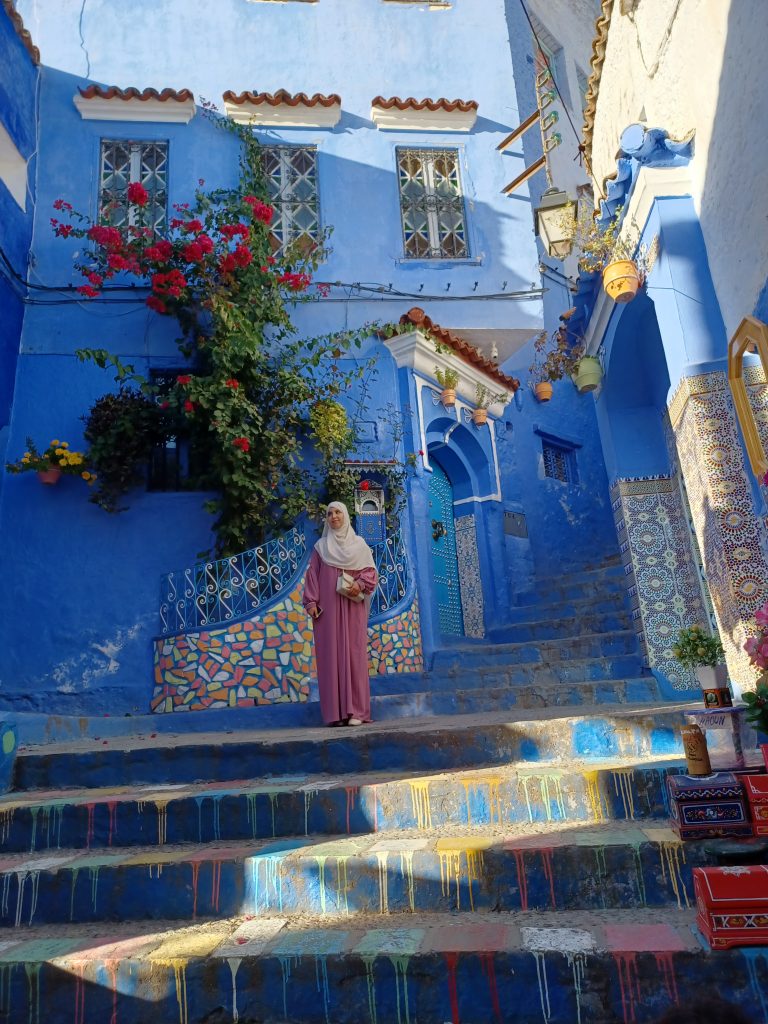
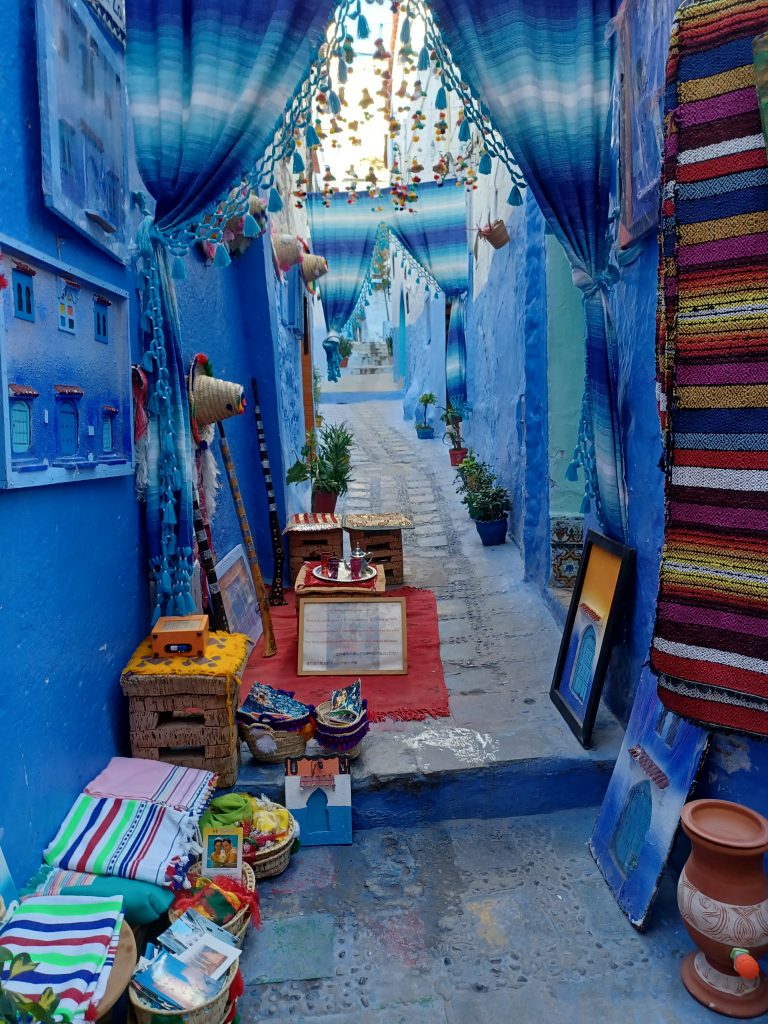
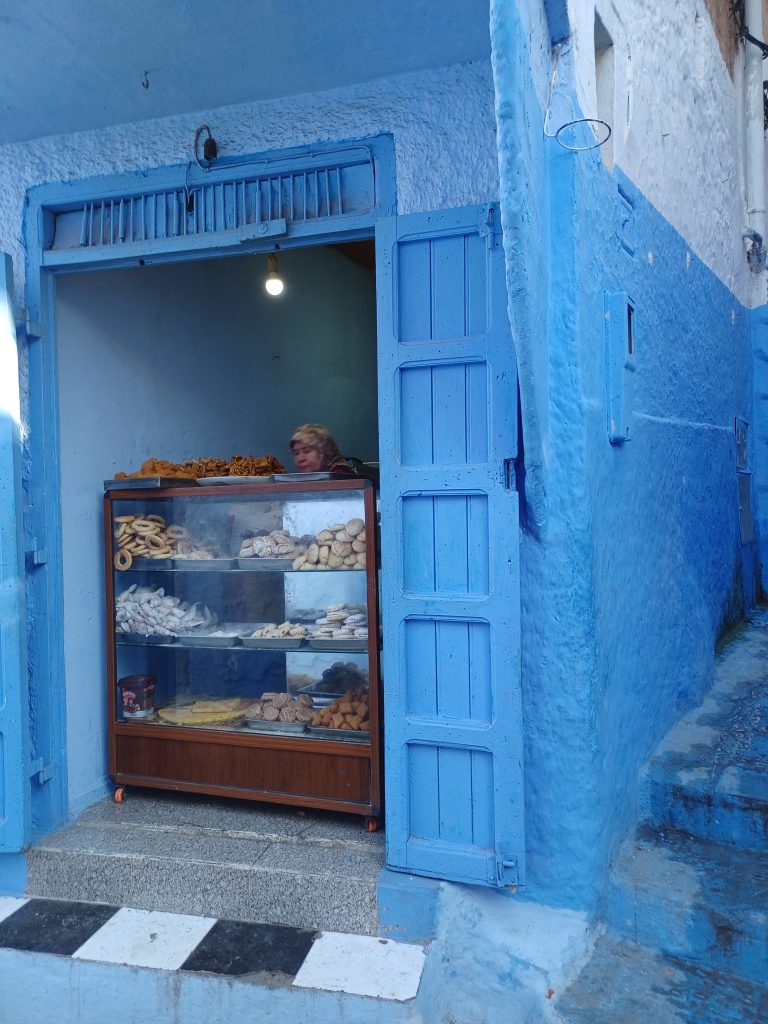
Pausing on every photogenic corner, we are eventually brought to the main Uta Hammam Square, the historical centre of the city. Surrounding it are vibrant outdoor cafes and cultural monuments, including the 15th century kasbah and the Great Mosque with its octagonal minaret.
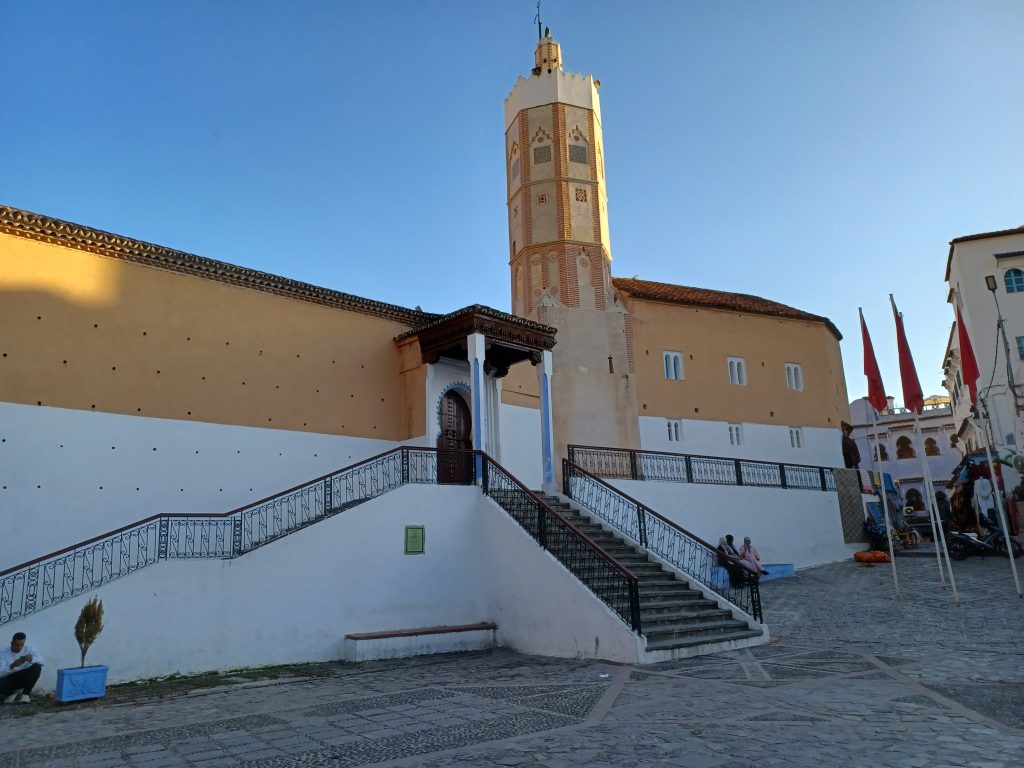
It is dinner time. The general consensus is that wine would be good with dinner. Myriad restaurants all around but “there is none in any restaurant except one”. It is ten minutes leg-stretch away and “many locals smoke there”. Extraordinarily tricky it is to find the route. GPS on. Still tricky. A local chap steers us toward the venue. He desires 100 dirhams for his efforts. Self not involved in the bargaining process. He gets 20, I gather, and is satisfied. “Shokran” Thank you. Met with congenial surroundings, soft musical background and mix of clientele: Arabs, Berbers, westerners. No smoke perceived and a splendid bottle of Moroccan red conveyed speedily to the table. Good food too.
Wander back to the main square and settle in a café overlooking it. Order nuss nuss – half coffee, half milk – and people watch: men in striped djellabas with the hoods up stride by. It is cold for the locals. Older women in long dresses and heads covered. Young men catapulting lights into the air in front of the kasbah, cheery open air cafés and tourists wheeling baggage to their hotels. Eventually make our way back to ours. A latish night.
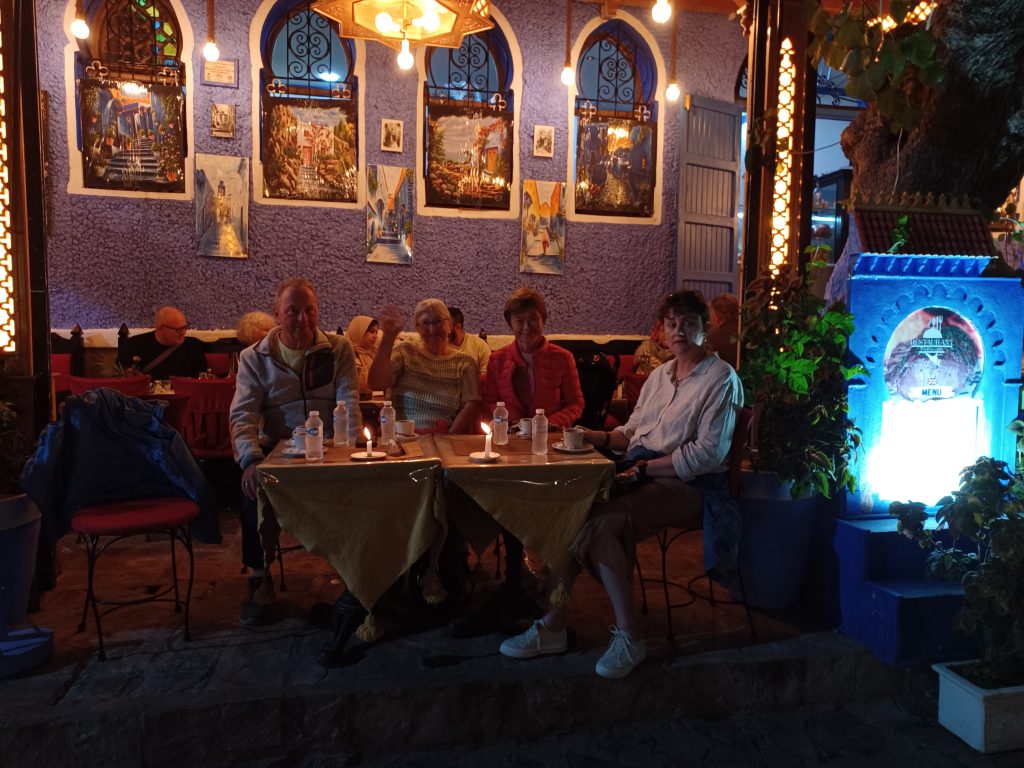
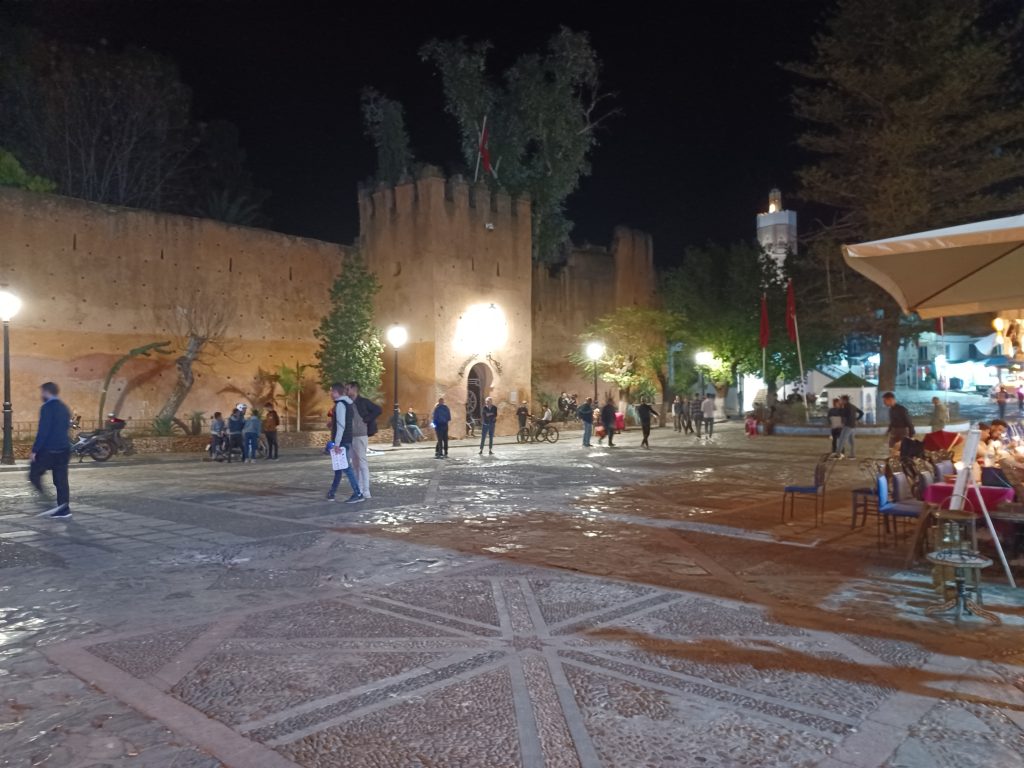
One thing which can sometimes discourage me from booking a tour, such as this, is getting up in the morning long before my usual rising time. Descend for breakfast in a kind of stupor and look vaguely around for a decent size mug in which to procure tea. Tiny cups. I take two. Put tea bag in one and then the other and pour not always boiling water into them and add milk on top. After two cups I am waking up a bit. Partake of a paltry breakfast. Simply cannot stuff it down in the early morning. I sit and watch other group members wolfing down omelettes and salads, sweet cakes and croissants. Exhausting. One of them, an energetic lady hailing from Singapore, is not in evidence this morning. She has apparently risen with the dawn to climb up a tallish hill on the outskirts of town to the Spanish Mosque on top. She generally consumes a massive breakfast and, in fact, nibbles nuts or some such thing throughout the day. Not a superfluous ounce on her either.
For the more leisurely crowd, the rest of us in fact, the morning continues with further strolling and shopping round Chefchaouen and taking photographs. We commiserate with our American participant over Trump’s election victory. He is not a happy man. Seems rather astonished at the strength of the victory. We encourage him to indulge in a bit of shopping therapy. He does. Purchases a short Moroccan woollen coat. Looks good. I buy a painting on canvas of a street scene with cat and a couple of soft camels, while one of the Australian contingent tries on some of the traditional babouches – leather slippers – of many colours.
We follow a small stream downwards, the tall hill in front of us, atop which is the aforementioned mosque. This was built by the Spaniards during colonial times to appease the local population but was never much used. Restored in 2007 more as a tourist attraction than anything else. The Singaporean lady swings by, still energetic after her morning climb up.
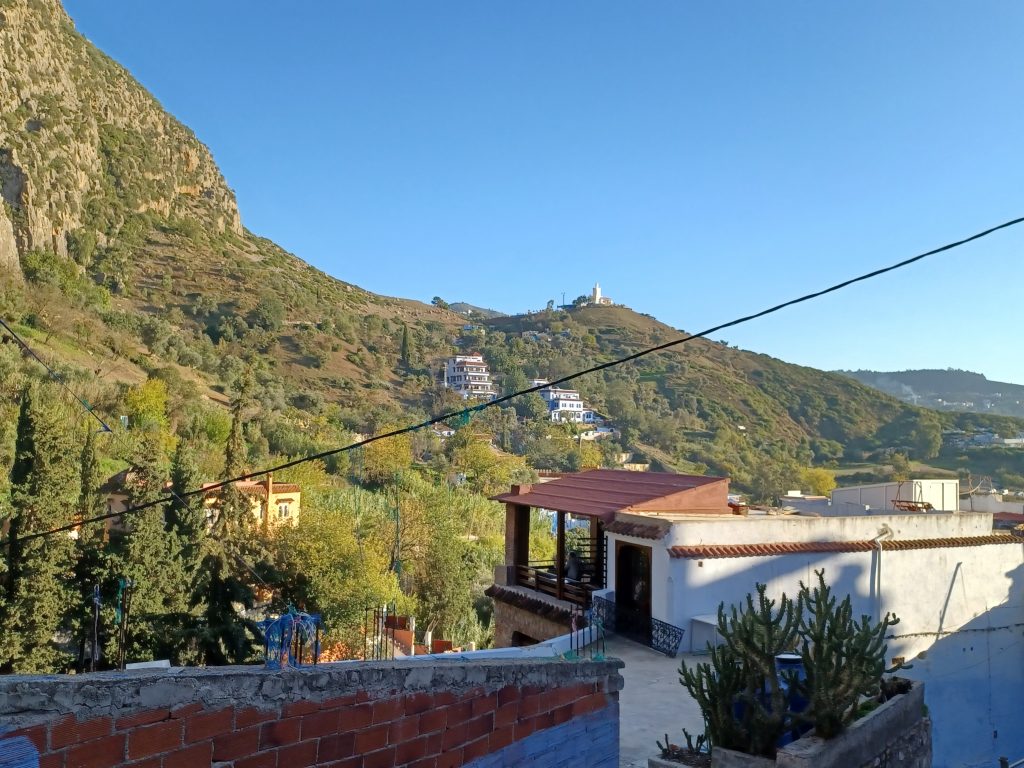
After a sedate luncheon, it is time to return to the hotel. Jesus darts about distributing tips to the deserving, while Mohammed, our genial driver, resting his elbow nonchalantly on the downturned window of the bus, awaits us. The Blue City is as far north as we are going on this trip. We are now turning south-about towards another of Morocco’s onetime capitals: Fez.

Leave a Reply